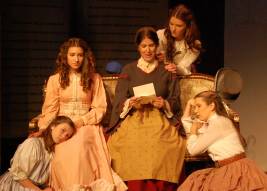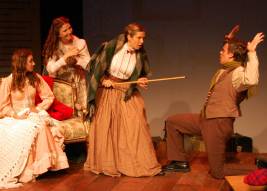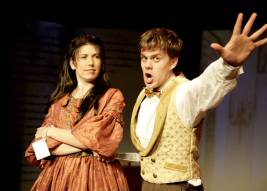
Little Women The Broadway Musical has been a favorite of mine since I first heard its tuneful score (music by Jason Howland and lyrics by Mindi Dickstein) and later saw a performance of the National Tour. Book writer Allan Knee somehow managed to compact Alcott’s 400-plus-word novel into a two-and-a-half hour musical which retains the book’s most memorable moments (Jo’s stealing a Christmas tree from the neighboring Laurence family’s property, jealous Amy burning Jo’s manuscript, Jo’s shame at finding a scorch mark on her gown the night of the big party, etc.) while adding songs which run the gamut from Jo’s feisty “Better” to the bouncy “I’d Be Delighted,” to the rousing Act 1 closer “Astonishing.”
I can’t imagine a better musical adaptation of the children’s and young adult classic than Howland and Dickstein’s, and now Anaheim Hills’ The Chance Theater has scaled down the 2005 Broadway production to intimate theater dimensions (a full orchestra becomes a single piano here), the smaller setting providing a particularly appropriate fit for Alcott’s family tale. Under Casey Long’s imaginative direction, a quintet of musical theater triple-threats bring the four March sisters to vibrant life (two actresses appear as Amy), and with its all-around excellent supporting cast, this is an evening of theater sure to enchant not only Little Women’s legion of fans but just about any musical theater aficionado.
Scenic designer Katherine Futterer sets the scene immediately with giant-sized pages from Little Women on either side of an upstage screen which initially shows the first two pages of Alcott’s most famous novel. Projected drawings of pen-and-ink sketches, looking like 19th Century book illustrations, replace these pages on the center screen as the story progresses, allowing quick scene changes to the story’s many locales.
At lights up, we’re in New York as aspiring writer Jo describes to her German friend Professor Bhaer a story she’s written. “It’s a mean and stormy night,” she begins. “The moors are bleak and bloody. Thunder claps. Lighting strikes. And there, Clarissa, her clothes in disarray, races across the wild coastal heath.” Then, as Jo continues her tale in song, lights come up on her sister Meg, friend John Brooke, and boy-next-door Laurie Laurence standing before those stage left and right pages and costumed as Clarissa, Braxton, and Rodrigo. As Jo tells her melodramatic adventure tale, her gestures are mimicked in perfect sync by the characters she’s created (or is she mimickingthem?). Rodrigo has just entered “in magnificent splendor” when Professor Bhaer interrupts Jo with a critique and some words of advice. Certainly Jo could do better than this, couldn’t she? “Better?!” exclaims an infuriated Jo. “My stories were a great success in Concord!”
We then flash back several years to the Concord, Massachusetts home of the March family. The year is 1863. The Civil War is still raging, and the family patriarch is serving as a Union Army chaplain. Left at home is his wife “Marmee” and daughters Meg, Jo, Beth, and Amy, who pass their time enacting Jo’s romantic adventure stories. Tomboy Jo dreams of being a writer, and when her Aunt March offers her the chance to travel to Europe as her companion (on condition that Jo learn to act like a lady), Jo jumps at the chance. Unfortunately for Jo, becoming a true lady is easier said than done, and when she discovers that jealous younger sister Amy has burned her latest story in a fit of pique, Jo reacts in a very unladylike manner.
For anyone unfamiliar with Little Women’s multiple plotlines, synopsizing ends here. Suffice it to say that there will be joys, sorrows, disappointments, romances, wedding proposals, and an ending promising much more still in store for the March sisters. (Alcott did, after all, write two sequels to Little Women.)
Chance Theater co-founder Erika C. Miller seems born to play Jo, and her work here is possibly her best ever. Absolutely captivating in the role, Miller’s spunky, romantic Jo grabs your attention (and heart) from the get-go, and she performs Jo’s many songs in a lovely, expressive soprano. Her sisters are equally well cast. Stephanie Philo is a warm and caring Meg (a kind of Marmee, Jr.), Melissa Dunham captures Beth’s innate sweetness (and has the strongest voice of the evening), and Sarah Pierce and Ali Axelrad manage to be entirely believable as younger and older versions of the same Amy. (The original Broadway production had a single actress as the youngest March sister, but having the adorable and gifted Pierce as young Amy makes the character’s childish moments far more believable than with an adult actress pretending to be twelve. The lovely Axelrad makes you believe that she is Pierce a few years later, and sings gorgeously.)
Brandon Sanchez is an absolutely winning Laurie, a boy any March sister would want to have as boyfriend or brother. Handsome Andrew Eddins does solid work as John Brook, the young man who steals Meg’s heart, and Jason James disappears into the stuffy yet secretly romantic skin of Professor Bhaer. All three are excellent singers, Sanchez not shirking from the challenge of that killer high note in “Take A Chance On Me.”
As Marmee, Eloise Coopersmith gets the show’s two most gorgeous, moving ballads (performed on Broadway by Maureen McGovern, a tough act to follow). Coopersmith sings them both with heartfelt emotion, and acts the part to perfection. Sherry Domerego is hilariously quirky as both Aunt March and Jo’s New York landlady Mrs. Kirk. Glenn Koppel couldn’t be better as gruff Mr. Laurence with a heart of mush.
In his first solo directorial assignment at the Chance, resident company member Long does a bang-up job, his personal touch everywhere, from clever bits of business to the three-dimensional characters his cast of actors have created. Jessie McLean has choreographed several charming dance sequences. Futterer’s set design is complimented by Masako Tobaru’s effective lighting. Rae Henderson’s costumes are period-perfect and fit each character’s personality to a T. Director Long is responsible for the production’s fine sound and projection design.
Musical director Mike Wilkins has done a good job with voices and harmonies. If only his piano accompaniment were at the level of the performers he is directing. I wish I could say I was imagining the many wrong notes and chords I heard throughout the evening. Hopefully, Wilkins’ playing will improve as the run progresses.
Fortunately, this is the lone minus in an evening of plusses. Little Women is the perfect musical for anyone who found Hair too edgy or Anne Of Green Gables too sweet. It somehow manages the nearly impossible, to appeal to children, teens, and everyone else from eighteen to eighty. I have the feeling that Little Women is going to be one of the Chance’s biggest musical hits ever. Laughter, romance, excitement, tears—Little Women The Broadway Musical has them all.
Chance Theater, 5552 E. La Palma Ave., Anaheim Hills.
www.chancetheater.com
–Steven Stanley
November 21, 2009
Photos: (l., c.) Tanae Beyer (r.) Doug Catiller, True Image Studio





 Since 2007, Steven Stanley's StageSceneLA.com has spotlighted the best in Southern California theater via reviews, interviews, and its annual StageSceneLA Scenies.
Since 2007, Steven Stanley's StageSceneLA.com has spotlighted the best in Southern California theater via reviews, interviews, and its annual StageSceneLA Scenies.







 COPYRIGHT 2024 STEVEN STANLEY :: DESIGN BY
COPYRIGHT 2024 STEVEN STANLEY :: DESIGN BY